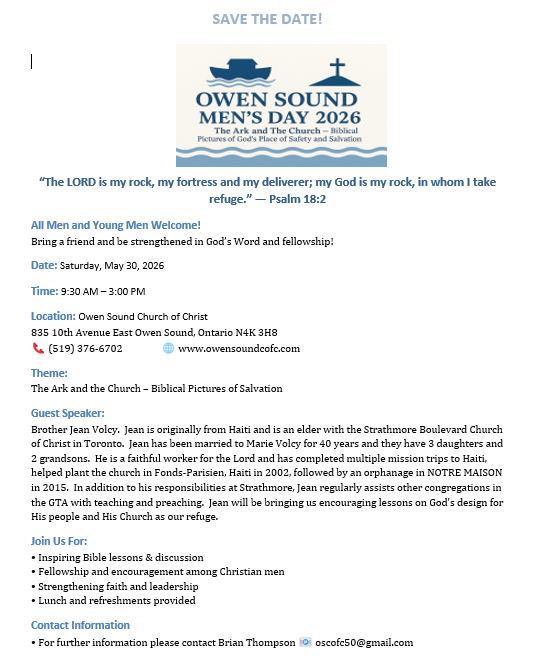In the fields of education, technology and even in government, change and innovation is sometimes beneficial and even necessary. These changes are indicative of our advancement in our civilization. Some changes however become detrimental to our society, as history has taught us.
In the church, a call for change and even reform is sounded. It is my conviction that as long as change or innovation is within the bounds of Matthew 28: 18-20; the command “to make disciples…baptizing them…teaching them to observe all things that I have commanded you…”; we are still in obedience to the command.
Improvements in transportation, technology and especially communication has greatly enhanced church efforts to evangelize. “Simulcast” (simultaneous broadcast) is made possible by the advancement in technology and communication. Now, we can join in worship with any church anywhere in the world, as it was during the Covid pandemic.








But some wanted more. They demand changes in leadership that do as much as possible to erase the distinctions drawn in scripture between male and female roles in the church..
Those roles are however – prescribed in the New Testament. They do not depend for their existence upon relative abilities or levels of education. The scriptures that address the subject along with known examples, are very clear.
In the context of the worship assembly, and in contrast with those who addressed the gathering, the apostle Paul instructed women “to keep silent in the church”. 1st Cor. 14: 34-35. He said this without further conditions, unlike his instructions for prophets and tongue-speakers. Prophets were to take turns and to speak one at a time while all others remained silent. In the absence of those with the gift of interpreting tongues, those with the gift of tongues were commanded to remain silent. And when Paul added that women were to remain ‘silent in the the church’, this instruction was not conditioned upon anything else. Silence had not suddenly changed it’s meaning, nor had the setting changed. Paul was still talking about who it is that addresses the congregation when assembled for worship and edification.
This passage has the advantage of being both clear and concise. It is good hermeneutical practice to allow passages of scripture that are clear to enlighten our understanding of those that are less so.
Now it turns out that what the apostle Paul said to the Corinthians, he repeated and enlarged upon this in his letter to Timothy over a decade later. Nothing had changed nor had God’s reasons changed.
Compare the following passages:
(1 Cor 11:3)
But I want you to understand that Christ is the head of every man, and the man is the head of a woman, and God is the head of Christ”
1 Tim 2:11-13
A woman must quietly receive instruction with entire submissiveness. But I do not allow a woman to teach or to exercise authority over a man, but to remain quiet. For it was Adam who was first created, and then Eve. And it was not Adam who was deceived, but the woman was deceived and became a wrongdoer.
Headship – both in the home and in the church was assigned by God and based upon his divine choice to create a man first and then a woman. No passage in either the Old Testament of the New invites us to weigh in on the subject. Our opinions about it and reactions to it – do not change a thing, except where we stand with God.
Unlike 1 Corinthians 11:13-15 and the question of head coverings, God does not ask us what ‘seems right to us’. He did it when considering head coverings, recognizing that cultural practices change. What ‘seemed right’ (or culturally self-evident) to those 2000 years ago in Corinth is not the same thing that ‘seems right’ to us. God has always reserved the right to regulate cultural practices and in this case he insists that our practices promote the guiding principles that He identifies for us.
By contrast, creation order and headship are of God alone. Those who want to mix and match these – fail to make this crucial distinction.
A second important principle for interpreting scripture has to do with context. We must always ask ourselves…’what is the question?’.
When the Apostle wrote to brothers and sisters in Galatia, what question was he answering or what issue was he clarifying when he penned these words?
Galatians 3:26-29
“For you are all sons and daughters of God through faith in Christ Jesus. For all of you who were baptized into Christ have clothed yourselves with Christ. There is neither Jew nor Greek, there is neither slave nor free, there is neither male nor female; for you are all one in Christ Jesus. And if you belong to Christ, then you are Abraham’s descendants, heirs according to promise”.
Was the question:
- What are the respective roles of men and women in the church?
- Is there any distinction between what men and women are permitted or commanded to do during the worship assembly?
Or was it:
- Now that the new covenant is here…the one purchased by the blood of Jesus, upon what terms does a person enter it and enjoy its benefits?
- Does such entry depend upon race, gender or social standing?
The problem was – that some of the Jewish leaders in the church were insisting that Gentiles had to first become Jews in order to qualify for entry into the kingdom of God (the church). And having entered in this way, there were trailing obligations from the Law of Moses that had to be adhered to in order to be saved.
So this passage has nothing to do with the first set of questions and everything to do with the second. A mix and match approach once again casts a shadow instead of shedding light.
Throughout scripture, leadership belongs to the head. The head of the church is Christ, and he has chosen to mediate his authority through others. As Paul observes, the church is…”built on the foundation of the apostles and prophets, Christ Jesus himself being the cornerstone.”
First century apostles and prophets were the direct source of inspired teaching, authoritative writing and served as the primary leaders of the church. In post-apostolic times, the church turned to those writings that now make up the New Testament scriptures. Those apostolic teachings were intended by God to be permanent relative both to matters of salvation and leadership for the on-going life of the church. And this is very important for understanding God’s will for the structure of His church.
In the New Testament, congregational polity is marked by local autonomy. Each congregation operates independently. The church in Syrian Antioch, did not interfere in the affairs of the church in Ephesus. They helped each other in times of need, as the churches in Macedonia and Achaia sent aid to the church in Jerusalem in their time of difficulty.
And then, all of the New Testament churches were instructed to adhere to the pattern of leadership set out by the apostles. They were ruled by a plurality of elders and served by deacons. This was corrupted in later centuries, when an unbiblical hierarchy was put in place; elevating a single bishop above the others.
But in the New Testament, alongside of evangelists, prophets and teachers, elders and deacons are the other two major leadership roles in the local church.
Distinguished from members at large, each group was to be made up of men who met the standards set out by God. (Titus 1:6-9; 1 Tim. 3: 1-13). But lest we miss the point, there were no women who served among them. So the actual practice of what we find in the church is in agreement with the instructions that we noted earlier for conduct in the assembly.
Each assembly is treated as an extension of the family. Headship in the family translated into headship in the church…where families assembled. Thus, wives were instructed to submit to their husbands in all things, and husbands in turn were to love their wives as Christ loved the church (Eph. 5: 22-28).
Male spiritual leadership – in scripture – did not arise as a result of culture. It was put there by God long before human “culture” arrived. It was by design that God made man the leader of his household and it is by his will that He has delegated qualified men to govern His household, the church.
END OF ARTICLE.
Reference: Jack Cottrell; The Faith Once And For All
Toronto, ON

